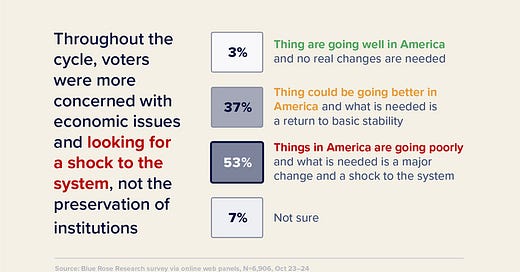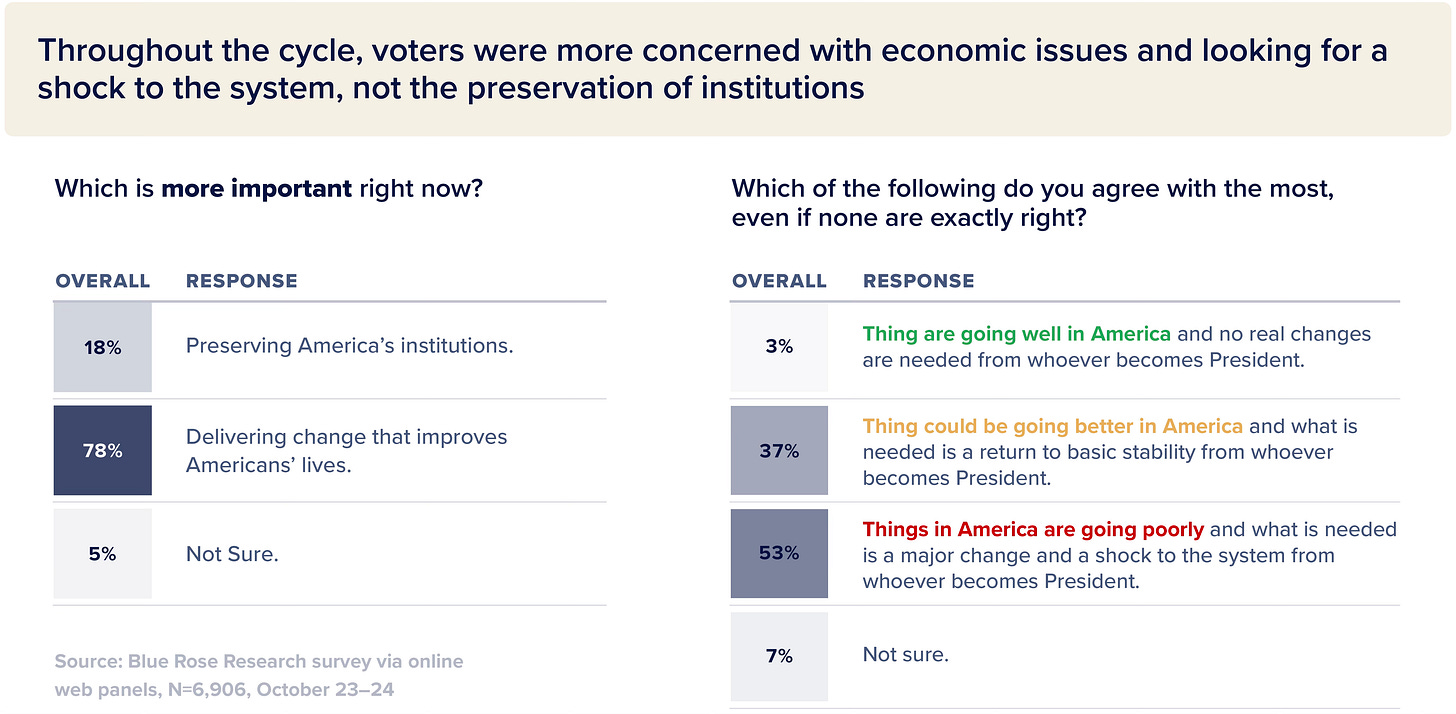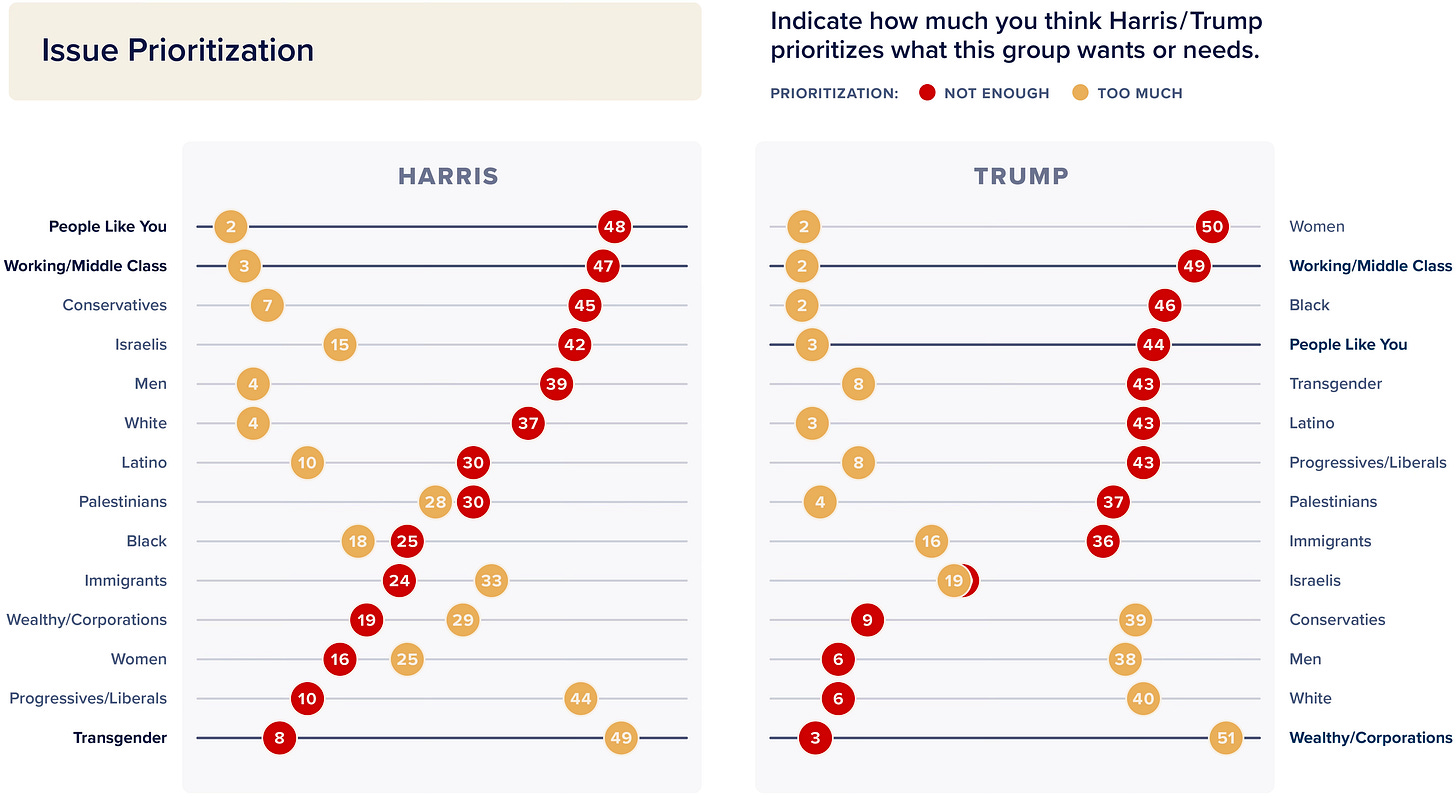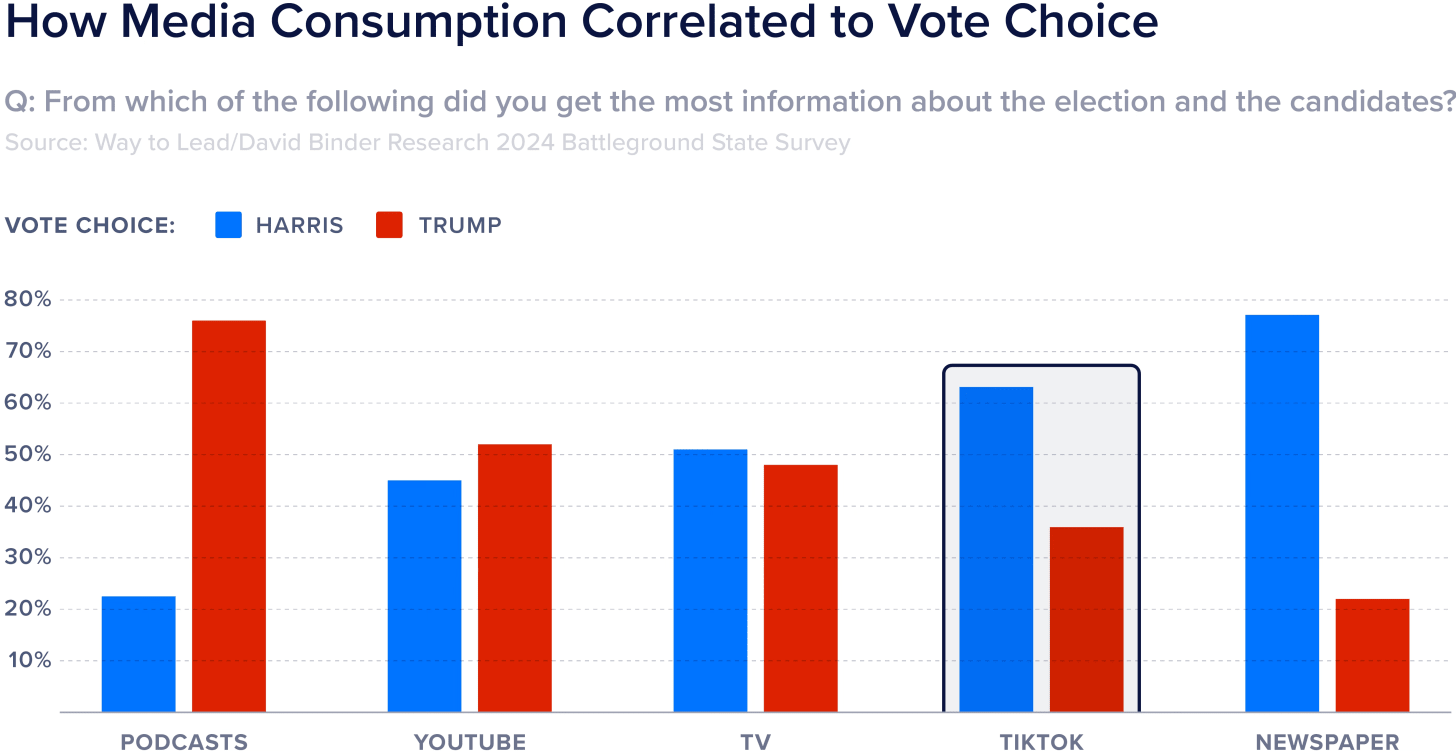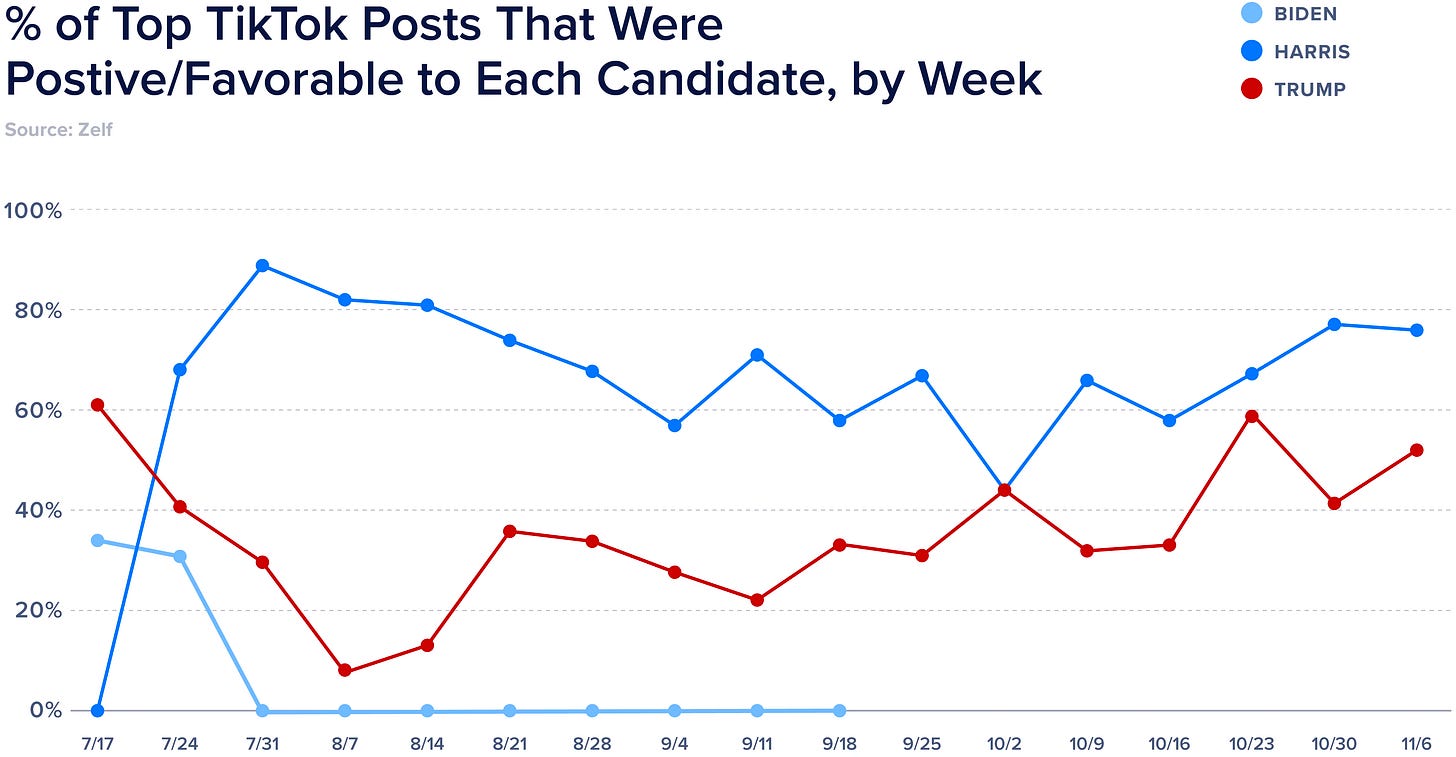Americans—And The Missing Biden Voters—Want Change
The 2020 Biden voters who skipped ‘24 are crucial to rebuilding a winning Democratic coalition
As fellow listeners to voters and analyzers of data, we were of course interested in David Shor’s election post-mortem interview with Ezra Klein. It turned out that much of what he said are things Way to Win has warned about for years, which came home to roost in the 2024 election cycle. Yes, Democrats failed to successfully engage their diverse coalition. Indeed, Democrats are rapidly losing ground with young men, in part because of a failure to understand the new media environment. Absolutely, voters had little-to-no faith that Democrats could adequately address the affordability crisis plaguing the country.
But there’s a missing piece of the analysis that we see as critical to understanding how we get out of this mess and rebuild a winning Democratic coalition: The missing 2020 Biden voters in the 2024 electorate. It’s true that the greater pool of 2024 non-voters may have largely favored Trump, but that truth obfuscates an important point—we aren’t trying to mobilize all the skippers, we’re trying to reengage our voters and motivate them to the polls. The fact that there was higher turnout among this group in the battleground states compared with other places across the country makes it clear that the strategy worked. The Biden skippers warrant further investigation, particularly for Democrats, so that we can understand not only where things went wrong in the lead up to 2024, but more importantly, avoid making the same mistakes in future cycles.
From all the deep listening we did with “gettable” Biden 2020 voters from 2021-2024, we know that this audience is deeply skeptical, but persuadable. They are not the same, as this new analysis from Stanford Professor Adam Bonica notes, as voters who may have shifted to Trump because of perceptions that the Democratic Party is “too far left.” They also should not be conflated with “all registered voters,” precisely because they have voted for Democrats in the past. That is why we believe it’s important—before drawing full conclusions—that we interrogate more fully the Biden 2020 voters who sat out 2024 to find out their motivations and how they could be re-engaged. We may argue about the specific number of these missing Biden voters, but there is no doubt they played a significant role in the outcome in battleground states, in addition to those who switched from Biden to Trump.
Way to Win has started to do just that as part of a comprehensive research project to be released in May, starting with focus groups that began last week focused on battleground state voters who are younger (18-35), Latino voters both male and female, and Black men. From this voter listening, we are beginning to see a picture of who these voters are and what it will take to get them back. Our podcast, Charting the Way Forward, will have sound and analysis from these voters in the coming weeks for those interested in following along.
Way to Win has long warned that Trump could consolidate his 2020 gains among nonwhite voters, particularly Latino men, unless campaigns and independent groups stopped assuming they would vote Democrat. In 2023 we urged Democrats to focus on a deeply populist appeal that showed a lot of appeal among the diverse “surge” voters of 2020 whom we needed to turn out in force in 2024. We have long pushed for a “mobisuasion” approach to voter outreach and messaging, which is summarized well in Bonica’s recent piece.
These findings reveal an often-overlooked truth: base mobilization and swing voter persuasion aren't opposing strategies—they work hand in hand. Momentum from strong base turnout creates an environment where persuadable voters are more likely to break in your direction.
Populism is key to this strategy at this moment and is even more salient now, as voters who supported Biden in 2020 but did not vote in 2024 almost universally resonate with a narrative that calls out the top 1% for taking $50 trillion in wealth from 90% of us over the past five decades through tax cuts, health care privatization, union busting, and corporate greed.
The other important and related point in Shor’s analysis is the data that show the vast majority of voters prefer a “shock to the system” change over basic stability, and that it’s more important to deliver change that improves Americans’ lives over preserving institutions.
As part of a research blitzkrieg we began in 2021 utilizing qualitative, quantitative and Randomized Control Trials (RCTs) to identify how different stories and messages landed across different segments, we found a strong, clear signal replicated across multiple modalities: voters’ overwhelming desire for more change. By large margins, voters across race yearned for the kind of change Biden had promised on the 2020 campaign trail. It’s important to remember that Biden’s legislative agenda to deliver that change was blocked repeatedly by members of the Party’s moderate faction, Joe Manchin and Kyrsten Sinema, neither of whom are still involved in Democratic politics.
Non-white voters’ deep desire for a better life, their perception that Biden didn’t deliver for them—which was false but a narrative pushed hard by Republicans—and their rightfully cynical views of politicians made them ripe for Trump’s chief contention of 2024, and what we have deemed this cycle’s “Big Lie”: Democrats care more about other issues, like Ukraine, Gaza, immigrants, or trans kids, than the challenges of ordinary Americans. Sure, it’s easier to make sense of the puzzle in hindsight, but the puzzle pieces were there, hiding in plain sight in our data, and it was something our Valiente Action Fund explicitly warned about among Latino voters. Ultimately, our 2024 post-election battleground poll with oversamples of Black, Latino, and AAPI voters revealed that voters across varying racial and education groups nearly all ranked “Jobs and The Economy" as their most important issue.
None of this research suggests that voters rejected Harris because she was too woke. Instead, persuadable voters frustrated with a lack of change they wanted stayed home, and Republicans used time-tested tropes about liberal Democrats to sell another group of persuadable voters on the idea that Harris was more invested in liberal causes than the cause of helping them.
This is why Trump’s infamous “they/them” ad campaign stuck with both pundits and voters alike. Shor cites it as only a 70% decile ad in RCTs, but it reinforced an existing damaging narrative—the Big Lie that Democrats had misaligned priorities—in a way that RCTs can’t fully measure. It also proves that on the Right, economic narratives are not limited to the kitchen table. They effectively used a social issue and the fear surrounding it to reinforce a largely economic argument. Our post-election polling showed how this worked on perceptions of issue prioritization, with 49% of battleground voters saying Harris was emphasizing transgender issues “too much” (the highest ranking on the scale) while at the same time, a roughly equal 48% of voters said Harris wasn’t focused enough on “People like you.”
Republicans also wielded their strong message across a diverse ecosystem of right-wing platforms that have provided a party bereft of good ideas with a profound messaging advantage over the past decade-plus.
Way to Win took a small but important chunk out of this advantage last cycle by taking aim at TikTok, a platform on which we identified in early 2024 that pro-Trump content was dwarfing pro-Biden content. With that in mind, we invested in and ran a massive TikTok-focused campaign from May to November. Our post-election battleground state polling showed that Kamala won most voters who said they primarily got their election news there.
New data from Kyle Tharp at Chaotic Era also shows that, in the end on TikTok, there was more positive Kamala content than Trump content, proving that where we compete, we can win.
All of our research over the last four years has led us to conclusions that similarly align with Shor’s analysis: Democrats failed to successfully engage our diverse coalition in 2024; we failed to make an economic argument that could break through—going beyond “kitchen table issues” to provide the seismic systemic change people clearly wanted; and we failed to fully grapple with the effects of a broken media environment in which Republican messages are dominating the landscape.
But the response to those failings isn’t moderation—which many Beltway pundits have been peddling about the path forward for Democrats. It’s finding ways to move into different battlegrounds, on which Way to Win has been the vanguard—rather than fighting in the same five states over and over again. It’s engagement and persuasion across a diverse group of voters. It’s learning to tell a better story that more fully meets the needs of voters and reaches them in more places through varying messengers. It’s not a matter of left versus center—it’s whether the Democrats will fight, not fold, on behalf of the 90% against the top 1% that has sucked away our prosperity while dividing us by our differences over the last five decades.
Trump told a fear-based populist story that there wasn’t enough to go around and promised voters that he would help them get their slice of the pie. Democrats need to tell a better story and make a stronger argument, steeped in an unapologetically populist vision, rooted in the basic value proposition of human dignity, and one that illustrates why their lives feel so irreversibly stuck.
And who better to start with than voters who have favored Democrats in the past but didn’t see fit to cast a ballot in 2024? As we look toward 2026 and 2028, Democratic strategists across the country will ultimately be working to appeal to every voter who has voted Democrat in one of the last several elections—a target group that will inevitably include millions of the missing Biden voters.

